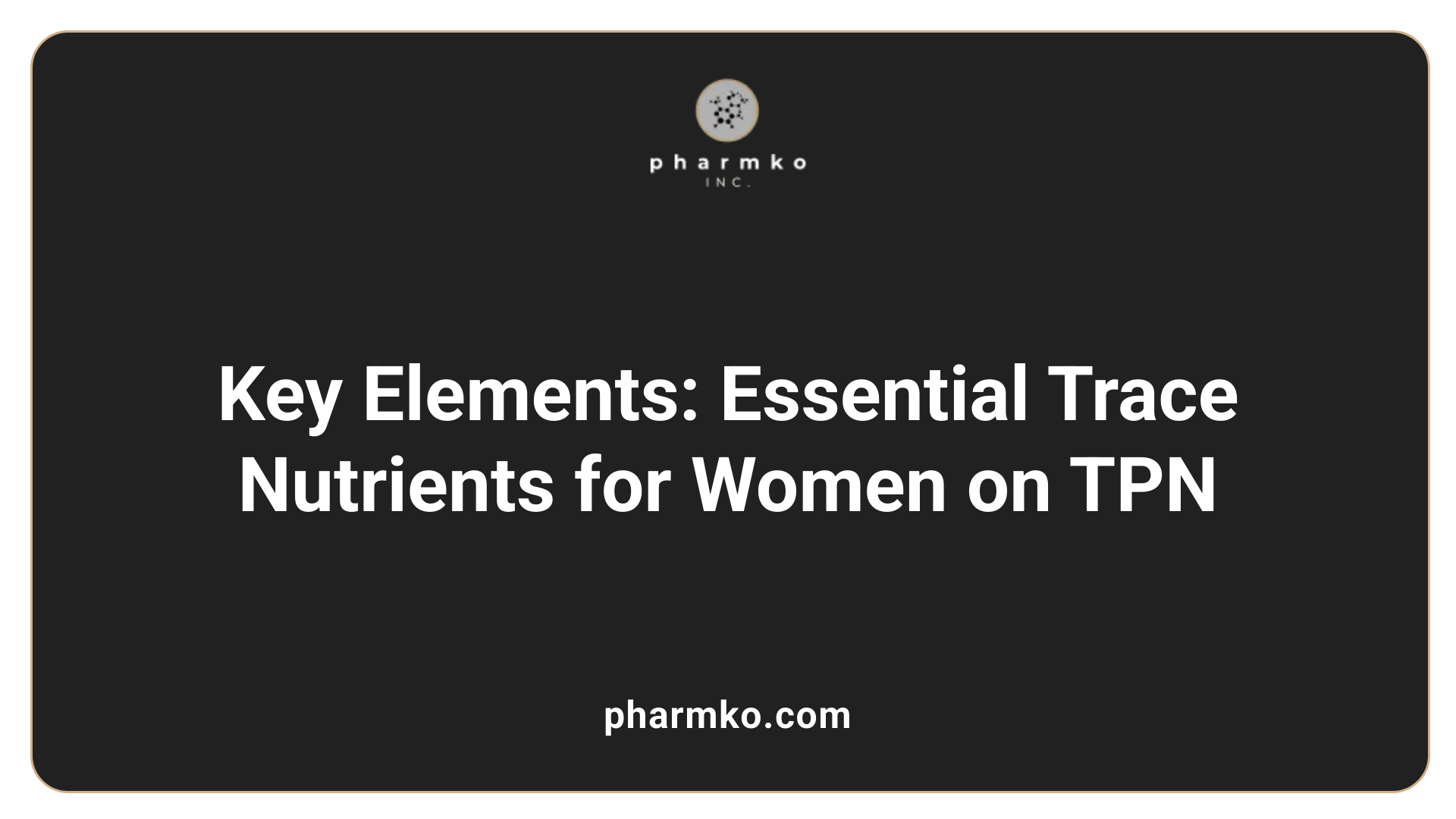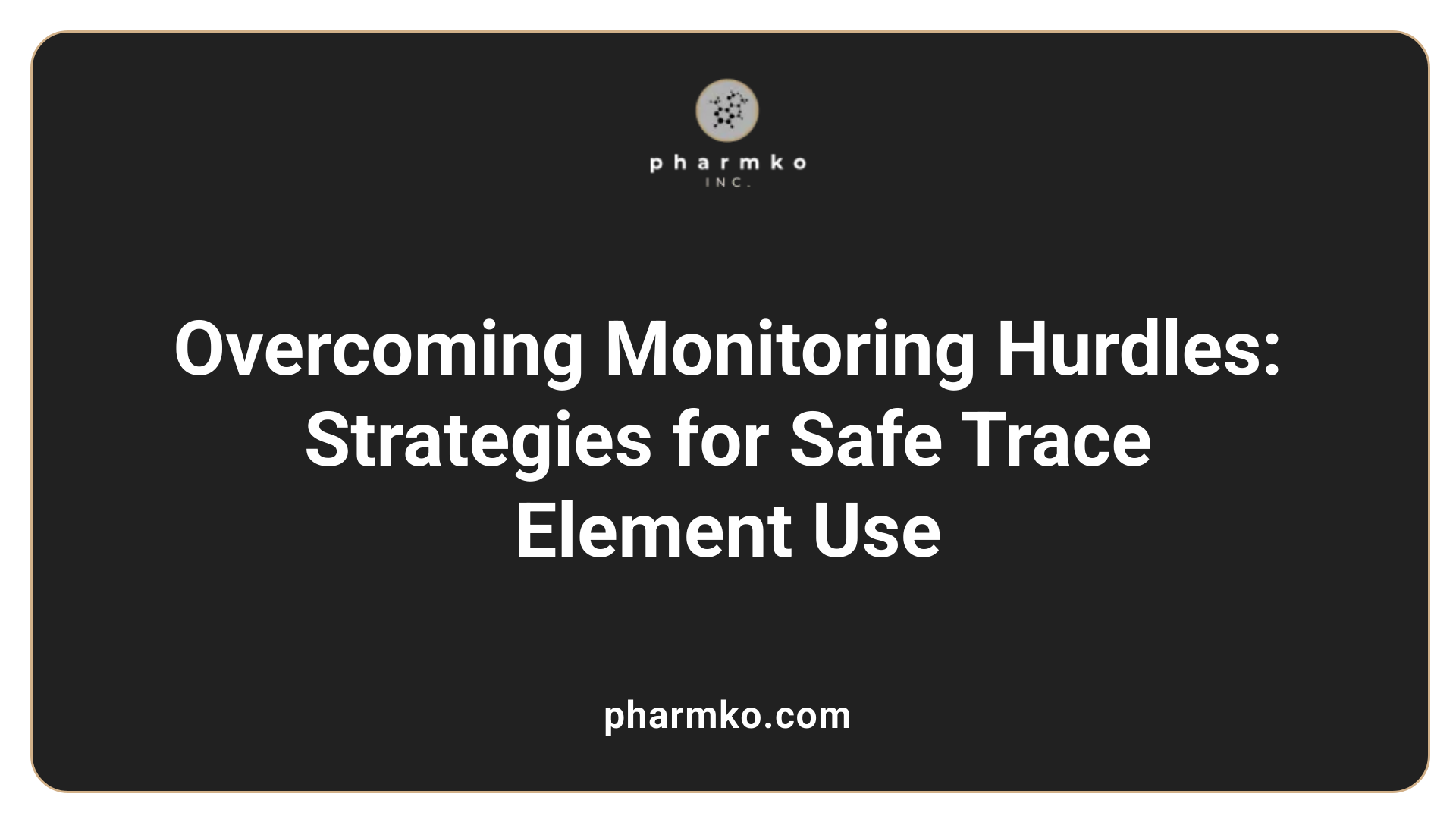Understanding the Role of Trace Elements in TPN for Women
An Essential Guide to Trace Element Management in Parenteral Nutrition for Women
Parenteral nutrition (PN) plays a critical role in supporting women with severe gastrointestinal impairments requiring long-term intravenous feeding. Central to this therapy is the inclusion of trace elements—micronutrients vital for numerous physiological functions. This article explores the integral functions of trace elements in TPN, emphasizing the importance of precise dosing, vigilant monitoring, and understanding their clinical implications for women. Leveraging current scientific insights and guidelines, we aim to provide healthcare professionals with comprehensive knowledge to optimize patient outcomes.
Essential Trace Elements in TPN for Women

What are the essential trace elements required in total parenteral nutrition (TPN)?
In TPN, several trace elements are essential to support various physiological functions, especially in women with long-term dependency on parenteral nutrition. The primary elements include zinc, copper, manganese, chromium, selenium, and molybdenum.
Zinc is crucial for immune defense, wound healing, and over 300 enzyme systems, with typical doses around 2.5-5 mg daily. Copper plays a vital role in iron metabolism, connective tissue formation, and nerve function; in TPN, its dose is often reduced to prevent accumulation, especially in cholestatic conditions. Manganese assists in bone health and enzymatic processes but can build up, risking neurotoxicity if improperly managed. Selenium acts as an antioxidant and is important in immune function; deficiency can lead to cardiomyopathy and muscle issues, with doses usually around 60-100 mcg per day. Chromium is essential for carbohydrate metabolism and insulin sensitivity, with daily doses of 10-15 mcg to maintain glucose regulation.
What is the function of trace elements in TPN therapy?
Trace elements function as critical cofactors for enzymes involved in vital biochemical reactions. They facilitate energy production, immune response, hormone synthesis, and cellular repair. For instance, iron and copper are fundamental in redox reactions, enabling oxygen transport and tissue oxygenation. Zinc is indispensable for immune regulation and tissue repair, while selenium contributes to antioxidant defenses, protecting cells from oxidative stress. Iodine is necessary for thyroid hormone production, which influences metabolic rate and development.
Since these elements are required in small but specific amounts, their presence ensures normal growth, immune competence, and metabolic homeostasis. However, an imbalance—either deficiency or excess—can lead to serious health problems. Therefore, precise dosing and monitoring in TPN are essential to harness their benefits while avoiding toxicity.
Why is monitoring and managing trace element levels important in patients receiving TPN?
Because TPN bypasses the gastrointestinal tract, it eliminates the body's natural regulation of nutrient absorption, increasing the risk of both deficiencies and toxicities of trace elements. Accumulation of elements like manganese and copper can cause neurological damage and liver dysfunction, especially in patients with impaired clearance due to cholestasis or hepatic disease.
Regular monitoring through laboratory testing—whether serum, plasma, or tissue levels—is indispensable for early detection of imbalances. Added complexities include contaminated PN solutions; for example, aluminum contamination can cause toxicity, particularly in patients with compromised kidney function.
Personalized management, considering disease state and individual patient needs, ensures that deficiencies are corrected without pushing trace elements into toxic ranges. This vigilance enhances recovery, maintains metabolic stability, and prevents long-term complications.
What are the guidelines for the administration and dosing of trace elements in TPN?
Guidelines recommend specific daily doses to optimize safety and efficacy. Based on A.S.P.E.N. standards and current evidence, typical dosages include:
- Copper: 0.3-0.5 mg/day, with reduced doses in cholestasis.
- Chromium: 10-15 mcg/day, monitoring for glucose control.
- Zinc: 2.5-5 mg/day, with higher doses in cases of high GI losses.
- Selenium: 60-100 mcg/day, especially in malabsorptive states.
- Manganese: Around 55 mcg/day, with caution due to neurotoxicity risks. Dosing should be adjusted based on laboratory results, clinical signs, and individual needs. Regular assessments of serum and tissue levels assist in fine-tuning therapy to prevent deficiencies or toxicities.
When should trace elements be held or adjusted in TPN therapy?
Adjustment depends on clinical and laboratory evaluations. For instance, in cholestasis, copper and manganese are often reduced or held to prevent accumulation. Elevated serum levels or signs of toxicity—neurological symptoms, organ dysfunction—warrant dose reduction or temporary withholding.
Monitoring trends over time informs when to adjust doses, especially since serum levels may not always reflect tissue stores accurately. Situations requiring adjustments include organ failures, toxicity signs, allergic reactions, or changes in metabolic demands due to illness or recovery.
Personalized adjustment minimizes risk and supports optimal nutritional status.
What are the clinical implications of trace element deficiencies or toxicities in women on TPN?
Deficiencies in elements like selenium, zinc, copper, or chromium can impair immune function, delay wound healing, cause hematologic abnormalities, and impair neurological development.
Conversely, excess intake—particularly of manganese and copper—may lead to neurodegenerative symptoms, organ damage, and hematologic issues. For example, manganese deposition in the brain can mimic Parkinsonian syndromes.
Routine lab monitoring with clinical assessments allows early identification of these problems. Correcting deficiencies with supplementation or limiting intake in cases of toxicity prevents long-term adverse effects. Ensuring balanced trace element therapy, therefore, significantly impacts overall health, recovery, and quality of life in women on long-term TPN.
Balancing Trace Elements to Minimize Toxicity and Deficiency Risks

What is the clinical significance of excess or deficient trace element levels in women on TPN?
In women receiving long-term parenteral nutrition (PN), maintaining proper levels of trace elements is critical for overall health and recovery. Both shortages and excesses can cause significant health issues. A deficiency in trace elements such as zinc, selenium, and copper can impair immune responses, delay wound healing, lead to neurological problems, and disturb blood cell formation.
Conversely, excess levels—particularly of manganese and copper—may cause toxicity. Manganese accumulation can deposit in the brain and produce Parkinson-like neurological symptoms, while copper overload can damage the liver and other organs.
Regulating trace elements within recommended ranges involves regular blood tests and clinical assessments. Customizing doses based on individual needs and ongoing monitoring helps prevent deficiencies or toxicities, contributing to safer PN therapy and better health outcomes.
Specific Challenges in Trace Element Monitoring and Management

What are the challenges in monitoring trace element levels in women on TPN?
Monitoring trace element levels in women receiving long-term parenteral nutrition (PN) involves several hurdles that can complicate effective management.
One major challenge is the limitation of laboratory testing. Serum levels are the most common measurement but often do not accurately reflect the body's overall tissue stores or functional status of trace elements. For instance, serum copper and ceruloplasmin levels can be influenced by factors beyond true deficiency or toxicity, such as inflammation or liver function abnormalities.
Tissue or organ-specific testing, which may provide a more accurate picture, tends to be invasive and is rarely practical for routine monitoring. Techniques like inductively coupled plasma mass spectrometry (ICP-MS) offer precise measurements, but they are costly, require specialized equipment, and are not always available in clinical settings.
Another obstacle is the biological variability among individuals. Factors such as disease state, organ performance, absorption, and metabolism can affect trace element levels. This variability necessitates a personalized approach, considering each patient's unique clinical picture.
Regular assessments—typically at least annually—help identify trends that suggest deficiencies or toxicities. However, the timing and frequency of testing should be tailored to the patient's clinical scenario, with more frequent monitoring during periods of instability or changing disease status.
Additionally, managing contamination risks, such as aluminum in PN solutions, adds complexity. Aluminum toxicity can mimic or exacerbate trace element imbalances, making precise assessment essential.
In summary, the primary challenges include limited laboratory accuracy, invasive testing requirements, individual biological variability, and contamination concerns. Overcoming these obstacles requires a careful combination of laboratory data, clinical signs, and a comprehensive understanding of each patient's context.
How can clinicians optimize trace element therapy amid monitoring challenges?
Optimizing trace element therapy in women on long-term TPN demands an integrated and individualized strategy.
First, clinicians should emphasize routine clinical assessments. These include evaluating for signs of deficiency—such as skin lesions or neurological symptoms—or toxicity, like neuropathy or abnormal hematologic parameters. Periodic physical examinations and symptom monitoring are vital components.
Second, laboratory testing should be employed judiciously. While serum measurements are practical, clinicians must interpret them cautiously, understanding their limitations. Trends over time tend to be more informative than isolated values. Tests such as serum copper, ceruloplasmin, zinc, selenium, and manganese can indicate trends toward deficiency or overload.
Third, therapy adjustments should be based on a combination of laboratory data, clinical signs, and patient-specific factors such as liver or kidney function, disease severity, and nutritional status. For example, if signs of copper deficiency appear alongside low serum copper, dose adjustments are warranted.
Adhering to guidelines from authorities like the American Society for Parenteral Nutrition (A.S.P.E.N.) helps standardize practices and ensures evidence-based care. Incorporating these guidelines with individualized patient data helps prevent deficiencies and toxicities.
Fourth, clinicians should be aware of potential interactions between trace elements and other nutrients, which can influence absorption and efficacy. For instance, high zinc doses can impede copper absorption, while excess manganese may deposit in the brain.
Lastly, education about the limitations of laboratory tests and awareness of contamination sources like aluminum enhances safety. Ensuring PN formulations are low in contaminants and monitoring for signs of toxicity can prevent adverse outcomes.
In conclusion, careful clinical evaluation combined with strategic laboratory testing and personalized dosing forms the backbone of effective trace element management in women on long-term PN. Recognizing and addressing monitoring challenges fosters safer, more effective nutrition support.
Integrating Best Practices for Trace Element Management in Women
Effective management of trace elements in women on TPN necessitates a balanced approach that combines current guidelines, vigilant monitoring, and personalized care. Recognizing the critical roles these micronutrients play in immune support, metabolic regulation, and neurological health underscores the importance of precise dosing and proactive assessment. As research evolves, clinicians must stay abreast of emerging evidence to refine strategies that minimize toxicity risks while preventing deficiencies. Ensuring safe and effective trace element therapy ultimately enhances clinical outcomes, promotes recovery, and sustains long-term health in women reliant on parenteral nutrition.
References
- [PDF] Trace Element Monitoring and Therapy for Adult Patients Receiving ...
- Trace Elements in Parenteral Nutrition - PubMed Central
- [PDF] Trace Element Supplementation and Monitoring in the Adult Patient ...
- Trace element supplementation in parenteral nutrition
- Dosing and Monitoring of Trace Elements in Long‐Term Home ...
- (PDF) Trace Elements in Parenteral Nutrition: Considerations for the ...
- Trace Elements 4 Injection: Package Insert / Prescribing Info
- Overview of dietary trace elements - UpToDate
- A.S.P.E.N. Position Paper - Vanek - 2012 - Nutrition in Clinical Practice













